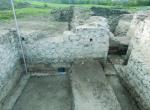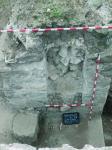Summary (English)
DEULTUM (Lyudmil Vagalinski – lvagalin@techno-link.com) The northeastern corner tower of the Late Antique fortification, preserved up to 4 m in height, was discovered with an adjacent postern to the south. The Late Antique fortification was built over earlier structures of the Roman period: cardo (cardo maximus?) with rooms along its western side and a temple, probably related to the Imperial Cult. A fire that occurred after AD 268 was documented. The Late Antique fortification was built after AD 297 and it narrowed the protected area of the city. The new northern fortification wall had an _ intervallum_ 3.60 m wide. The defenders were able to walk along a secret longitudinal passage within the eastern fortification wall, 75 cm wide, and thus to reach the postern located close to the northeastern corner tower. A fire that occurred after AD 313 was documented. In the same year, Maximinus Daza fought against Licinius in Southeastern Thrace and later Licinius fought against Constantine the Great. An attack that occurred after AD 378 was documented, most probably carried out by the Goths who defeated Emperor Valens on the 9th August in the same year in the Battle of Hadrianopolis located not so far from Deultum. Pieces from iron plated mail ( lorica segmentata ) were found in the burned debris. In the 5th century AD, the inner side of the northern fortification was reinforced with a massive wall. The fortification was destroyed at the end of the 6th century AD. After AD 778, the northeastern corner tower was used as a quarry for building material. The archaeobotanical samples showed the application of oak timber in the Late Antique fortification. The zooarchaeological analysis showed that oxen, pigs and sheep/goats prevailed, but horses, hens, gooses, deer, storks and Black Sea shells also occurred. A large dog, probably guard dog died in this fortification tower, too. The finds included mostly weaponry, 60 coins and a fragment from a Latin funerary inscription that was reused in the northern fortification wall.
- Lyudmil Vagalinski - Archaeological Institute with Museum
Director
- Lyudmil Vagalinski - Archaeological Institute with Museum
Team
Research Body
- Archaeological Institute with Museum






![Download [PDF]](/excavation/skins/fasti/images/results/download_sml.png)

